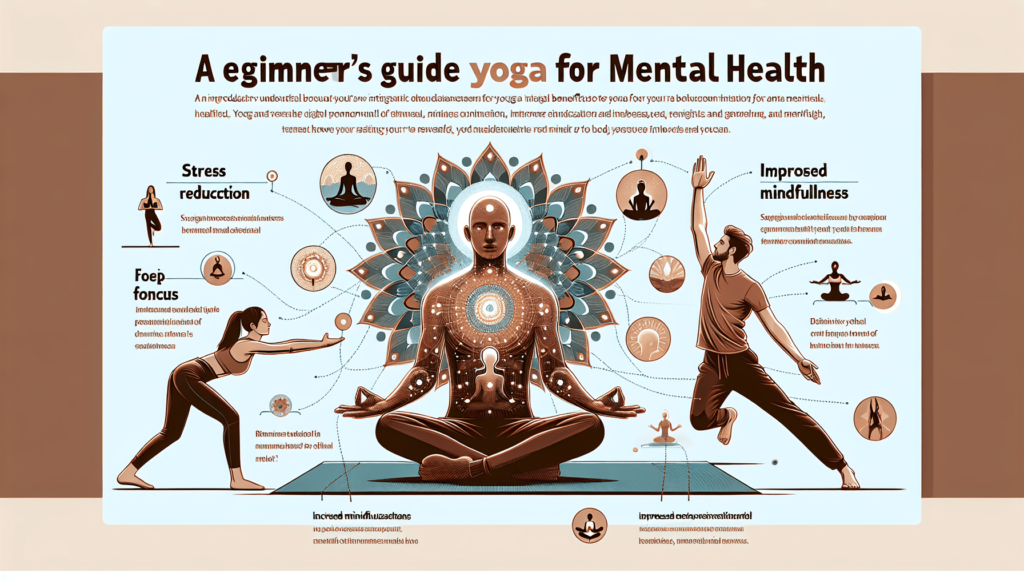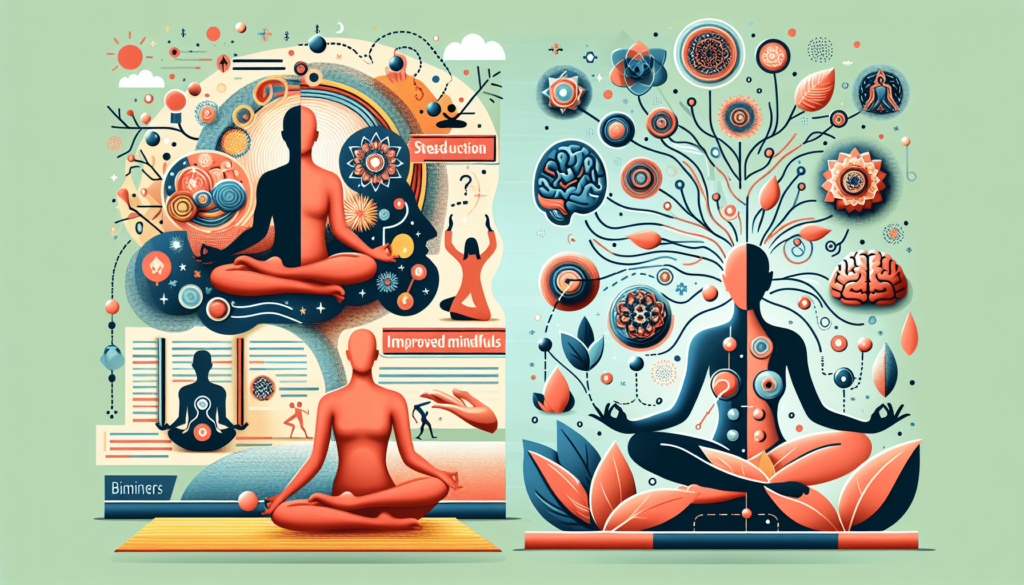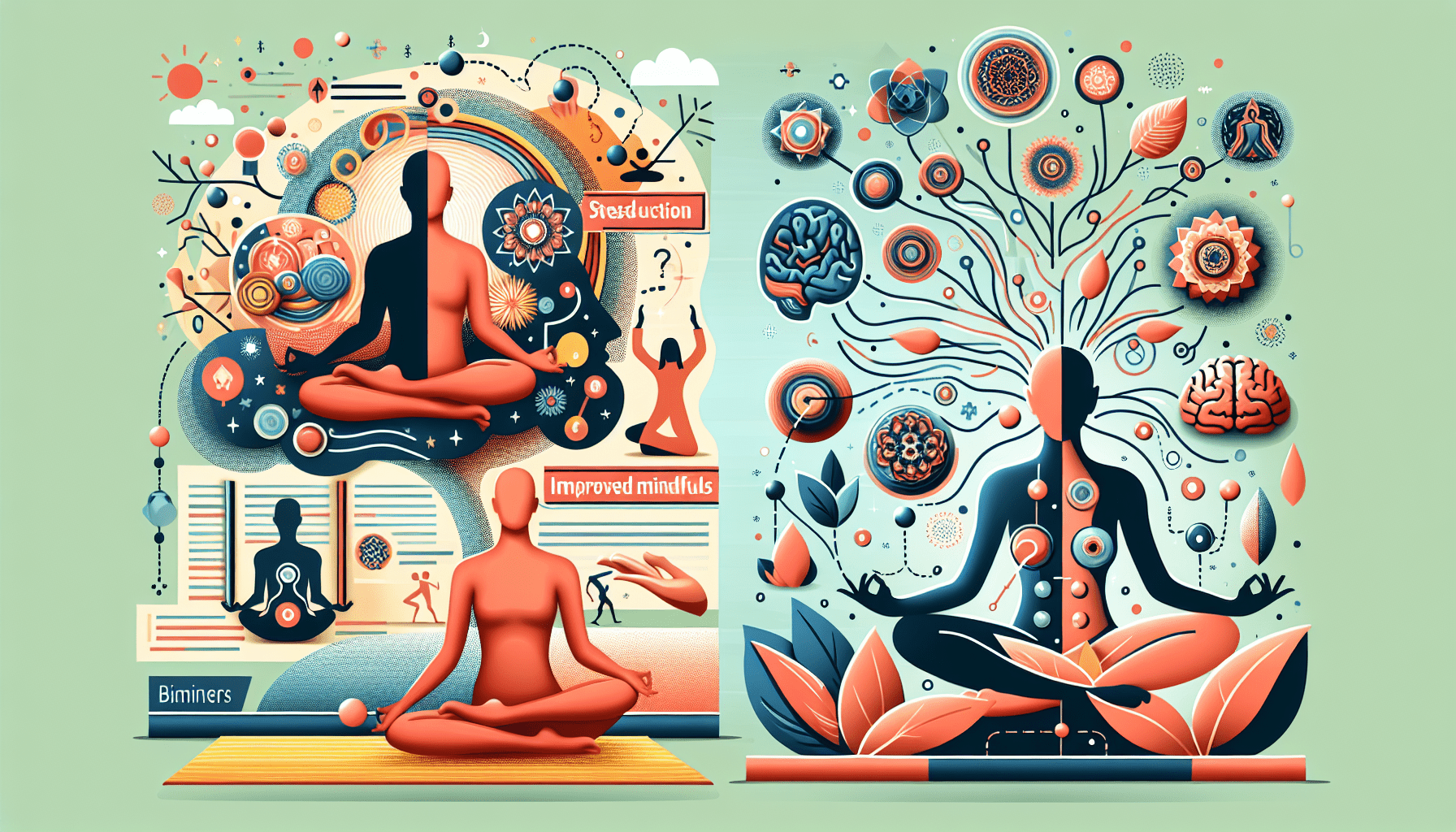If you’re looking to improve your mental health and well-being, yoga could be just the practice for you. As a yoga instructor, I’m here to guide you through the basics and provide you with an introduction to the powerful benefits of incorporating yoga into your daily life. Whether you’ve never tried yoga before or have limited experience, this article will give you a glimpse into how yoga can positively impact your mental health. So, let’s explore the incredible world of yoga together and discover the transformative effects it can have on your mind, body, and spirit. Get ready to embark on a journey of self-care and inner peace!

What is Yoga?
Yoga is a centuries-old practice that originated in ancient India. It is a holistic system that encompasses physical postures, breathing techniques, meditation, and ethical principles. The word “yoga” comes from the Sanskrit word “yuj,” which means “to unite” or “to join.” Yoga is often described as the union of the mind, body, and spirit.
History of Yoga
The history of yoga dates back thousands of years. It is believed to have been developed around 5,000 years ago by the Indus Valley civilization. The origins of yoga can be traced to the ancient texts known as the Vedas, which are the oldest scriptures of Hinduism. Over time, various schools of yoga were established, each with its own philosophy and practices. Today, yoga is practiced and embraced by people from all walks of life around the world.
Definition of Yoga
Yoga is more than just a physical exercise or workout. It is a comprehensive practice that involves the integration of breath, movement, and mindfulness. At its core, yoga aims to promote overall well-being and cultivate a sense of balance and harmony within oneself. It encourages self-discovery, self-acceptance, and self-transformation.
Benefits of Yoga
Engaging in a regular yoga practice can bring about a multitude of benefits for both the body and the mind. Some of the key advantages of yoga include:
- Stress reduction: Yoga helps to calm the mind and relax the body, leading to a reduction in stress levels.
- Increased flexibility and strength: Regular practice can improve flexibility and strengthen muscles, leading to improved physical posture and alignment.
- Boosted energy levels: Yoga practices, such as invigorating sequences and specific breathing techniques, can help to increase energy levels and vitality.
- Improved mental health: Yoga has been shown to alleviate symptoms of anxiety and depression, improve sleep quality, and enhance overall mental well-being.
- Enhanced focus and concentration: Practicing yoga can improve focus, concentration, and cognitive function.
- Better self-awareness: Engaging in mindful movement and breath awareness can help to cultivate a greater sense of self-awareness and self-reflection.
- Overall physical fitness: Yoga is a great complement to other forms of exercise and can contribute to an overall improvement in physical fitness.
Yoga and Mental Health
Understanding the Mind-Body Connection
Yoga recognizes the intricate connection between the mind and the body. It acknowledges that our mental and emotional well-being can significantly impact our physical health, and vice versa. By focusing on the breath, movement, and meditation, yoga helps to cultivate this mind-body connection and promote overall balance and harmony.
Effects of Stress on Mental Health
Stress is a common and pervasive issue that can significantly impact our mental health. Chronic stress can lead to the development or exacerbation of various mental health conditions, such as anxiety and depression. It can also contribute to physical ailments and affect overall well-being. Yoga provides a holistic approach to managing stress by focusing on relaxation, breath control, and mindful movement.
Role of Yoga in Improving Mental Health
Yoga is increasingly recognized as a valuable tool for improving mental health and well-being. It offers a safe and non-judgmental space to explore and release emotions, reduce anxiety and depression, and cultivate resilience. The combination of physical activity, deep breathing, and mindfulness allows individuals to tap into their inherent strength and find inner peace and balance.
Physical Benefits of Yoga
Improves Flexibility and Strength
One of the key physical benefits of yoga is improved flexibility and strength. Through the practice of various yoga poses, or asanas, the body becomes more supple and adaptable. This increased flexibility can contribute to better posture, reduced muscle tension, and improved range of motion. Additionally, many yoga poses require strength and stability, which helps to tone and build muscle.
Boosts Energy Levels
Contrary to popular belief, yoga is not always a calming and restorative practice. There are many dynamic and energizing sequences that can help to boost energy levels. Through the combination of movement, breath, and concentration, yoga stimulates the body and mind, leaving practitioners feeling invigorated and revitalized.
Enhances Posture and Balance
Poor posture can lead to various physical ailments, such as back pain and muscle imbalances. Yoga helps to correct and improve posture by strengthening the core muscles and promoting proper alignment. Additionally, balance poses in yoga challenge the body’s equilibrium and improve stability, which can be beneficial for people of all ages.

Mental Benefits of Yoga
Reduces Anxiety and Depression
Yoga has been shown to have a positive impact on individuals struggling with anxiety and depression. The combination of physical movement, breath awareness, and mindfulness helps to regulate the nervous system and promote a sense of calm and relaxation. Regular practice can reduce the symptoms of anxiety and depression and enhance overall mental well-being.
Increases Mindfulness and Self-Awareness
Mindfulness is the practice of being fully present in the present moment, without judgment or attachment. Yoga encourages individuals to cultivate mindfulness by focusing their attention on the breath, sensations in the body, and the present moment. By developing this awareness, individuals can better understand their thoughts, emotions, and patterns of behavior, leading to greater self-awareness and personal growth.
Improves Sleep Quality
Sleep is essential for overall health and well-being. However, many individuals struggle with insomnia or poor sleep quality. Yoga can help improve sleep by promoting relaxation and reducing stress levels. Incorporating gentle yoga stretches and relaxation techniques before bedtime can help to calm the mind and prepare the body for a restful night’s sleep.
Getting Started with Yoga
Choosing a Yoga Style
There are various styles of yoga, each with its own unique focus and approach. It’s essential to choose a style that aligns with your goals and preferences. Hatha yoga is a gentle and accessible style, while Vinyasa yoga is more dynamic and flowing. Ashtanga yoga is a vigorous practice, and Yin yoga focuses on deep stretching and relaxation. Explore different styles and find one that resonates with you.
Finding a Suitable Yoga Class or Instructor
Attending a yoga class or working with a qualified instructor can provide guidance, support, and personalized instruction. Look for classes or instructors that offer beginner-friendly options and prioritize safety and proper alignment. Consider trying out different classes or studios until you find one that feels comfortable and welcoming.
Essential Yoga Equipment
Yoga requires minimal equipment, making it accessible to people of all fitness levels. The most essential piece of equipment is a yoga mat, which provides stability and cushioning during poses. You may also want to invest in yoga blocks, straps, and blankets to assist with modifications or provide additional support. Wear comfortable clothing that allows for unrestricted movement.
Basic Yoga Poses for Mental Health
Mountain Pose (Tadasana)
Stand tall with your feet hip-distance apart and your arms relaxed by your sides. Ground through your feet and engage your leg muscles. Lengthen your spine, lifting the crown of your head towards the sky. Relax your shoulders away from your ears and take slow, deep breaths. Mountain pose promotes stability, grounding, and a sense of inner strength.
Child’s Pose (Balasana)
Kneel on your mat and sit back on your heels. Spread your knees wide, allowing your chest to rest between your thighs. Stretch your arms forward and lower your forehead to the mat. Breathe deeply and surrender into the pose, releasing tension from the body and calming the mind. Child’s pose promotes relaxation, introspection, and a sense of safety.
Corpse Pose (Savasana)
Lie flat on your back, with your legs extended and your arms relaxed by your sides. Close your eyes and allow your body to completely relax into the mat. Focus on your breath and let go of any tension or stress. Savasana promotes deep relaxation, rejuvenation, and a connection to the present moment.
Breathing Techniques in Yoga
Deep Belly Breathing
Deep belly breathing, also known as diaphragmatic breathing, involves consciously breathing deeply into the lower abdomen. This type of breathing activates the parasympathetic nervous system, promoting relaxation and reducing stress. To practice deep belly breathing, sit comfortably with your hands on your abdomen. Inhale deeply through your nose, allowing your belly to expand. Exhale slowly through your nose, letting your belly gently contract. Repeat for several breaths.
Alternate Nostril Breathing
Alternate nostril breathing, or Nadi Shodhana, is a balancing breathing technique that helps to calm the mind and balance the energy channels of the body. To practice alternate nostril breathing, sit comfortably with your spine straight. Close your right nostril with your right thumb and inhale slowly through your left nostril. Close your left nostril with your ring finger and exhale through your right nostril. Inhale through your right nostril, close it with your thumb, and exhale through your left nostril. Repeat for several rounds.
Victorious Breath
Victorious breath, or Ujjayi breath, is a deep, audible breath that creates a whisper-like sound in the back of the throat. This breathing technique helps to calm the mind, increase focus, and regulate the breath. To practice victorious breath, sit comfortably and inhale deeply through your nose. As you exhale, gently constrict the muscles at the back of your throat, creating a soft “hissing” sound. Continue this deep, rhythmic breath for several minutes.
Yoga and Meditation
Benefits of Combining Yoga and Meditation
The combination of yoga and meditation can have profound effects on mental health and overall well-being. Yoga prepares the body and mind by releasing tension and creating a sense of calm. Meditation cultivates mindfulness and inner peace by focusing the attention and quieting the mind. Together, these practices enhance self-awareness, reduce stress, and promote a deep sense of relaxation.
Guided Meditation Practices
Guided meditation is a wonderful way to begin a meditation practice, especially if you are new to the practice or have difficulty focusing. A guide or instructor leads you through a series of instructions and visualization exercises, helping you to relax and enter a meditative state. There are many guided meditation apps and online resources available to help you get started.
Mindfulness Meditation
Mindfulness meditation involves paying non-judgmental attention to the present moment. It requires focusing on the breath, bodily sensations, thoughts, or emotions without getting caught up in them. Mindfulness meditation cultivates awareness, acceptance, and compassion. Set aside a few minutes each day to practice mindfulness meditation, gradually increasing the duration as you become more comfortable.
Yoga for Specific Mental Health Conditions
Yoga for Stress and Anxiety
Yoga is a valuable tool for managing and reducing stress and anxiety. It promotes relaxation, deep breathing, and mindfulness, all of which can counteract the effects of stress on the body and mind. Incorporate gentle yoga practices, such as restorative or Yin yoga, into your routine to provide a space for relaxation and stress relief.
Yoga for Depression
Yoga has been shown to be beneficial for individuals struggling with depression. The combination of physical movement, breath awareness, and mindfulness can help to alleviate symptoms of depression and improve mood. Practice energizing yoga sequences, such as Vinyasa or Ashtanga yoga, to uplift the mind and body.
Yoga for PTSD
Yoga can be a helpful tool for individuals experiencing post-traumatic stress disorder (PTSD). The gentle movement, breath control, and mindfulness in yoga can help individuals regulate their emotions and promote a sense of safety and grounding. Gentle and restorative yoga practices, such as Yoga Nidra or Hatha yoga, can be particularly beneficial for individuals with PTSD.
Precautions and Safety Tips
Consultation with a Healthcare Professional
Before starting a yoga practice, it is important to consult with a healthcare professional, especially if you have any pre-existing health conditions or injuries. They can provide guidance and ensure that yoga is safe and suitable for your specific needs. Always listen to your body and modify or skip poses as needed.
Modifying Poses for Individual Needs
Yoga is a practice of self-care and self-awareness. It is essential to honor your body’s limitations and modify poses to suit your individual needs. Do not push yourself beyond your comfort zone, and feel free to use props, such as blocks or straps, to support your practice. It’s okay to take breaks or choose gentler options when necessary.
Listening to Your Body
The most important aspect of a yoga practice is listening to your body. Pay attention to any sensations, discomfort, or pain, and adjust accordingly. If a pose feels too intense or causes pain, back off or modify it. Each body is unique, and it’s crucial to honor your body’s limits and practice with self-compassion and patience.
In conclusion, yoga is a transformative practice that offers numerous physical and mental health benefits. By cultivating a mind-body connection, reducing stress, improving flexibility, and enhancing self-awareness, yoga can contribute to overall well-being and improved mental health. Whether you are a beginner or an experienced practitioner, incorporating yoga into your life can be a rewarding and enriching experience. So take a deep breath, roll out your mat, and embark on a journey of self-discovery and self-care through the practice of yoga. Namaste!
